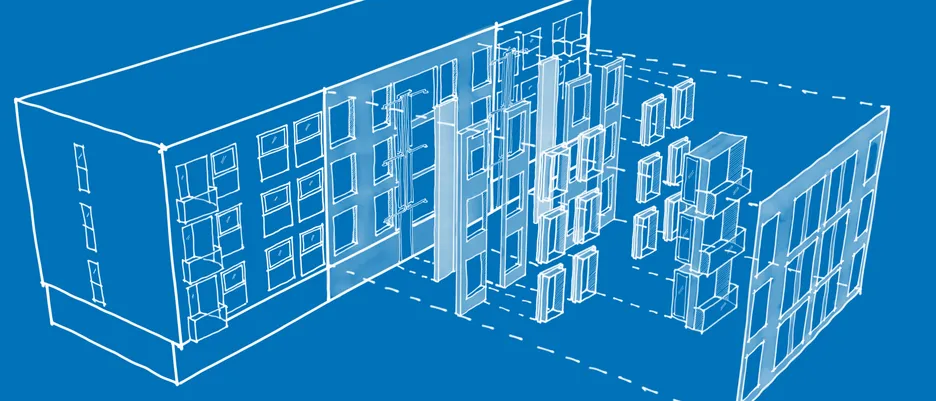
2nd SKIN
Demonstrator & SCALER Project
The EU needs a zero-energy (ZE) refurbishment rate of around 3% to achieve its 2050 targets for a low carbon urban environment. The current refurbishment rate is far too low, despite all the policy measures over the past years. Although technically feasible, ZE-renovation projects developed in recent years are still too expensive, often suffer from disappointed inhabitants and unexpected higher energy-use.
2nd SKIN achieves the challenge by:
- Providing a second skin around the existing building, integrating renewable energy production and all utilities (heating, cooling, ventilation, hot water and day-light control).
- Decoupling the renovation of the façade from the renovation of the interior.
- Causing limited disturbance for the occupants.
- Maintaining and upgrading the installations from the outside, reducing maintenance costs.
- Involving residents to ensure satisfaction with the process, the resulting dwelling, its systems and a zero energy outcome. A framework is in place for the user-approach that helps residents accept 2nd SKIN and supports them in their post-renovation life practices.
- Integrating expertise and objectives of stakeholders in a new business model that offers a standardized product-/service solution instead of traditional one-off projects.
2nd SKIN Demonstrator project
The 2nd SKIN Demonstrator project in Vlaardingen comprises a renovation of 12 dwellings to a “Net Zero-Energy Ready” standard and delivers already lots of insights in the huge challenges of how this approach can be scaled up in order to create a vast impact on the transition towards a low-carbon, healthy and livable urban landscape.
Important lessons learnt for the large-scale implementation:
- User-approach (communication, user-involvement, feedback) resulted in an exceptionally high tenant acceptance rate of 100%.
- The technological solutions applied are calculated to deliver a net Zero-Energy Use on an annual basis.
- The technologies available for integration as sub-systems in 2nd SKIN are currently still voluminous, heavy and costly. The various subsystems still need be scaled down, to become not only smaller, but also fitting to the actual demand, lighter and better integrated in the skin.
- The financial feasibility of the 2nd SKIN-approach is crucial for upscaling.
2nd SKIN SCALER project
The porch apartment buildings in the ‘Indische’ neighbourhood in Vlaardingen are an ideal case for the up-scaling of the 2nd SKIN project by means of two strategies. In this part of Vlaardingen, N=195 porch apartments are designated for deep energy renovation. In the scaler project the complex apartments that remain to be renovated will be used for the execution of the two 2nd SKIN upscaling strategies. N=171 apartments will be renovated ‘Net Zero-Energy Ready’ and N=12 will be ‘Full Net Zero-Energy’ V2.0.
1. Net Zero-Energy Ready
The approach developed for the Demonstrator Project will be optimized for the large scale implementation for the present-day market situation. That implies that the 2nd SKIN approach will become a highly efficient (A++-label) solution and ‘Net Zero-Energy’ Ready. A part of the high-costs installations needed to become energy neutral are substituted by affordable high-end solutions. The 2nd SKIN solution will be optimized in that sense that the installations can be upgraded after 12 to 15 years when the (first-) lifecycle of the installations is coming to an end, so the houses then can be transformed towards full energy-neutral habitats.
2. Full Net Zero-Energy V2.0
In order to minimize the time needed to get the fully energy-neutral the 2nd SKIN approach market ready, the Demonstrator Results will be assessed and the approach optimized. Besides the optimization of the whole renovation process (user acceptance, building and communication), special attention will be paid to the optimization of the installations for large-scale production.